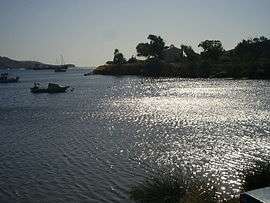
Kea
The kea (/ˈkiː.ə/; Māori: [kɛ.a]; Nestor notabilis) is a large species of parrot of the superfamily Strigopoidea found in forested and alpine regions of the South Island of New Zealand. About 48 cm (19 in) long, it is mostly olive-green with a brilliant orange under its wings and has a large, narrow, curved, grey-brown upper beak. The kea is the world's only alpine parrot. Its omnivorous diet includes carrion, but consists mainly of roots, leaves, berries, nectar, and insects. Now uncommon, the kea was once killed for bounty due to concerns by the sheep-farming community that it attacked livestock, especially sheep. It received full protection in 1986.
The kea nests in burrows or crevices among the roots of trees. Kea are known for their intelligence and curiosity, both vital to their survival in a harsh mountain environment. Kea can solve logical puzzles, such as pushing and pulling things in a certain order to get to food, and will work together to achieve a certain objective. They have been filmed preparing and using tools.

Kea (island)
Kea (Greek: Κέα), also known as Gia or Tzia (Greek: Τζια), Zea, and, in antiquity, Keos (Greek: Κέως, Latin: Ceos), is a Greek island in the Cyclades archipelago in the Aegean Sea. Kea is part of the Kea-Kythnos regional unit.
Geography
It is the island of the Cyclades complex that is closest to Attica (about 1 hour by ferry from Lavrio) and is also 20 km (12 mi) from Cape Sounio as well as 60 km (37 mi) SE of Athens. Its climate is arid, and its terrain is hilly. Kea is 19 km (12 mi) long from north to south and 9 km (6 mi) wide from west to east. The area is 129 km2 (50 sq mi) with the highest point being 560 m (1,837 ft) above sea level
Its capital, Ioulis, is inland at a high altitude (like most ancient Cycladic settlements, for fear of pirates) and is considered quite picturesque. Other major villages of Kea are the port of Korissia and the fishing village of Vourkari. After suffering depopulation for many decades, Kea has been recently rediscovered by Athens as a convenient destination for weekends and yachting trips. The population in 2011 was 2,455.

Kea (ferry)
M.V. Kea (sometimes called the Seabus Kea) is a commercial passenger ferry that operates the busy Devonport-Downtown Auckland express route for Fullers Ferries (Auckland's largest ferry operator). The Kea operates a regular service departing from Downtown Auckland every half hour.
The Kea was purpose-built in Whangarei for Fullers, and entered service in 1988 as the 14th ferry of the company.
The Kea can carry approximately 400 passengers on her two passenger decks , while the bridge area forms a third deck. Her distinctive design is similar to earlier Auckland ferries in that she is longitudinally symmetrical, effectively meaning that she can be driven both ways, so that no U-Turns at the starts or finishes of crossings have to be made. This enables the Kea to maintain a half-hourly express service between Downtown Auckland and Devonport.
In 2007, she was removed from the water and given a substantial overhaul in a shipyard in the Western Reclamation, including major work on both engines.
Podcasts:
-
by Kuraia
Kea
by: KuraiaIspiluak hausten ditugu
gure aurpegia erakusteko
zerua desestali dugu
zaindarietaz barre egiteko
su ematen gaituzue
ta kixkali beharrean
kea gera bihurtu
begiak zirikatuz
arnasa meatxatuz
eztula eraginez
beti haurkituko gaituzue
KEA!KEA!KEA!KEA!
paradisuko sinboloen kontra
KEA!KEA!KEA!KEA!
hauek sortutako itzalak
KEA!KEA!KEA!KEA!
argitzeko beti prest
KEA!KEA!KEA!KEA!
su ematen gaituzue
ta kixkali beharrean
kea gera bihurtu
begiak zirikatuz
arnasa meatxatuz
eztulka itotzeko
erretzen banazu
ez duzu arnastuko.
Latest News for: kea
Watch: The solar-powered plane launched from a car near Christchurch that flies continuously around the Earth
Stuff 05 Apr 2025Mauna Kea Technologies Announces Entrance Into Exclusive Negotiations for a Licensing Agreement for Cellvizio® in an Important Therapeutic Area With a Major Industry Player (Mauna Kea Technologies SA)
Public Technologies 01 Apr 2025Inside Information / Other news releases (Mauna Kea Technologies SA)
Public Technologies 01 Apr 2025Li-S Energy collaborates with Kea Aerospace to power high altitude UAV flights
 Victoria Advocate
31 Mar 2025
Victoria Advocate
31 Mar 2025
'Hard to say' why kea numbers on rise
Otago Daily Times 31 Mar 2025Kea caught nibbling on rescue chopper
Otago Daily Times 31 Mar 2025Mauna Kea Technologies Announces the Opening of a Safeguard Proceeding to Restructure Its Financial Liabilities (Mauna Kea Technologies SA)
Public Technologies 31 Mar 2025Kea population booms in Aoraki
RNZ 31 Mar 2025Best 5 stargazing locations in the world sees a surprising entry in Hawaii’s Mauna Kea
South China Morning Post 20 Mar 2025Top 20 Must-See Archaeological Sites on Cyclades in Greece
Greek Reporter 20 Mar 2025- 1

